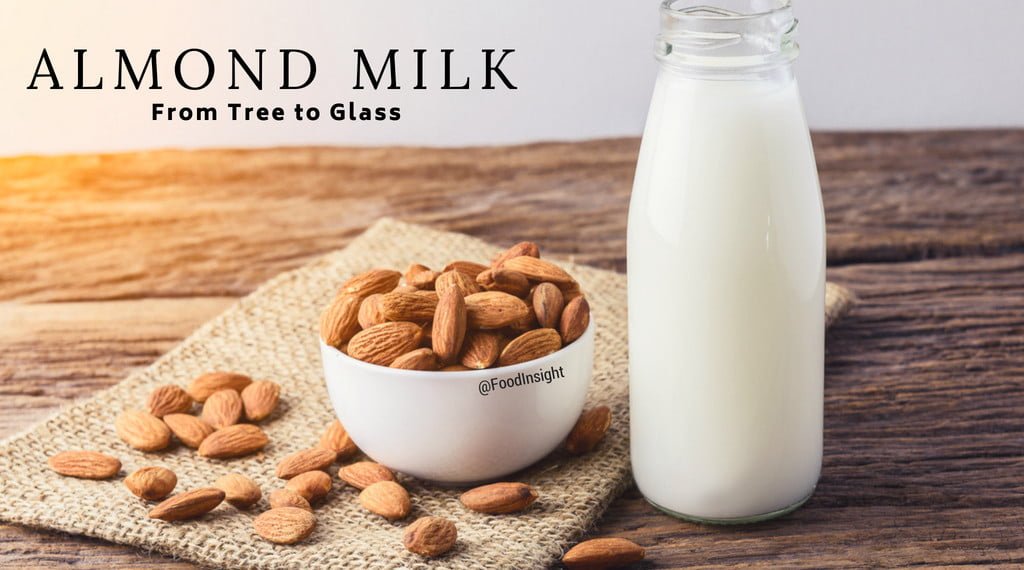We hope that you’ve been able to “milk” our new resources about how cow’s milk and soy milk are produced. The next installment in our series is almond milk, a notable crowd-pleaser as a non-dairy milk alternative. While you may enjoy almond milk in your cereal, oatmeal or alongside a plate of cookies, have you ever contemplated how it is made? If so, you might be surprised by the journey an almond takes from the tree to your glass.
The Almond Harvest Shuffle
Almond milk is, of course, made from almonds, which are well-known, nutritious tree nuts. But before we talk milk, let’s talk almonds a bit more.
About two-thirds of the world’s almonds are produced in the United States, predominantly in California. They are harvested from orchards annually, typically beginning in August, and continuing through October or November. Once they are harvested, they are transported to processing facilities to be hulled, and sometimes also shelled to retrieve the almond nut, or the “meat.”
Harvested almonds can be sent to one of two different post-harvest facilities: those that remove the outer hull to produce in-shell almonds as a final product (known as hullers), and those that both hull and shell the almonds, leaving the inner meats as a final product (known as huller/shellers).
Facilities that both hull and shell the almonds can then send the meats to secondary production facilities where they can be used to manufacture various consumer products, including almond milk.
Get a Pail and Start Milking?
Almonds don’t have udders, so you may be wondering what is in almond milk. It consists mainly of ground-up almonds (minus the pulp), filtered water, a thickening agent (like carrageenan) and sometimes a sweetener (like sugar). Other ingredients include emulsifiers (which keep water and other components from separating).
Some almond milk also has different flavorings added to enhance taste, as well as sources of protein and other nutrients to enhance the nutritional profile. Depending on the brand, you may also find other ingredients to preserve the almond milk as well.
Nut Milk Nutrition Notes
Almond milk is chock full of nutrients such as fiber, vitamin A and calcium, for fewer than half the calories of 1 percent low-fat milk. However, if you are looking for a protein-rich dairy alternative, almond milk might not be the best option because it contains only about one gram of protein per eight-ounce serving. Almond milk can be used in many dishes where milk is used, but it does have a more nutty taste than milk and other milk alternatives. Almond milk is also a great option for those who are lactose-intolerant.
All Good with Almond Milk?
While almond milk provides consumers with an alternative to dairy milk, it has been accused of environmental sustainability issues. Growing almonds is a tall order when it comes to water usage: Some life cycle analysis reports have noted that one liter of almond milk uses 1,611.62 gallons of water for production, as opposed to one liter of cow’s milk, which uses 77 gallons of water. However, almond milk production emits far fewer greenhouse gases than the production of cow’s milk.
Almond farmers acknowledge the water demands of their orchards, but they don’t want their crops singled out as “greedy water guzzlers.” The California Almond Board has noted that almond trees use about the same amount of water as most other California fruit and nut trees. Almond farmers work strategically to use water responsibly and efficiently. This not only supports their productivity, but it also supports their environmental stewardship efforts.
Beyond their meat, almonds can yield additional agricultural products. For instance, the hulls and shells can be used for livestock feed and bedding, and trees can be recycled at the end of their productive lives to create alternative energy or to improve soil quality.
When it comes to almond milk or other beverages, manufacturers aim to use water sustainably and to reuse water where possible. It can be a big task, but it’s an important one that requires ongoing and diligent efforts by food companies.
Stay tuned to our Milk Series! Next in our line-up is coconut milk.
